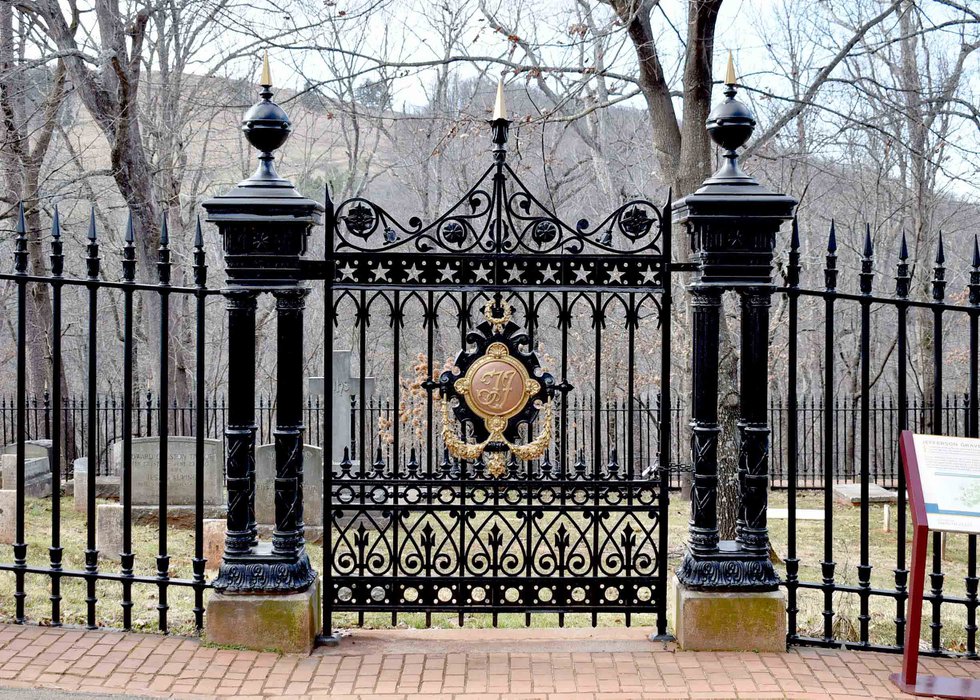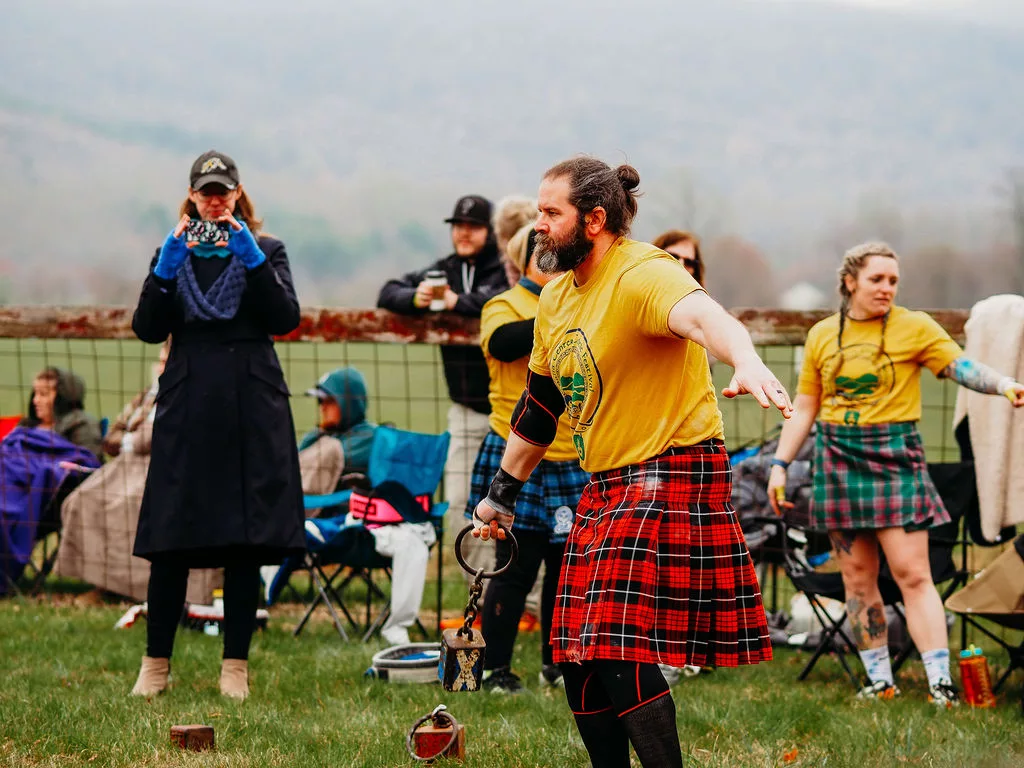The history of the state is all around us.

Wrought iron fencing with cast iron seal on the Jefferson family cemetery at Monticello. Courtesy of James O’Neil
Virginia’s affinity for wrought iron began as far back as 1607, when Capt. John Smith wrote of the Jamestown settlement: “Our best commoditie was Yron which we made into little chissels.”
Today we associate wrought iron more with fences than “little chissels,” but in 18th-century America, they were a luxury enjoyed only by the wealthy. A century later, though, iron fences were more affordable and thus more common, thanks to enhanced iron production and casting techniques (melted iron is poured into molds to cool). Mail-order catalogs offered Virginians myriad design options, and the growing rail system allowed rapid delivery from vendors near and far.

Restoration work by Chase Architectural Metal on James Monroe’s tomb in Hollywood Cemetary, Richmond. Photo
by Ɱ on Wikimedia Commons.
However, that availability makes tracing a fence’s history tricky. Not all fence makers marked their work, although some attached identifying shields or plates to gates, posts, or hinges. Among those found in Virginia are Robert Wood & Co., Hanika Iron Fence Co., Springfield Architectural Iron Works, Asa Snyder, and F.J. Barnes.
And, of course, fences have been repaired, replaced, and reproduced over the centuries. “Saw a picket in half, and I’ll tell you right away if it’s old or not,” says Robert Chase, president of Richmond-based Chase Architectural Metal. His company has restored and preserved valuable historic metalwork all over the state, including James Monroe’s tomb enclosure at Richmond’s Hollywood Cemetery and projects at the Virginia Museum of Fine Arts and Virginia State Capitol.
Although some historic fences were lost to World War II scrap iron drives, many remain anchored in Virginia’s historic homes, churches, public buildings, and cemeteries.
Richmond

Men pouring iron at O.K. Foundry’s original 17th Street location in Richmond, c. 1940. Photo courtesy
James O’Neil.
Richmond is home to a rich collection of historic iron, thanks in part to the Tredegar Iron Works—once the largest iron producer in the South. A regional rail center, the city was also home to scores of smaller foundries and ironworks. Much of Richmond’s ornamental iron was documented by Robert P. Winthrop and the Valentine Museum in the 1980 book Cast and Wrought, The Architectural Metalwork of Richmond, Virginia. He asserts that Richmond’s collection is “second only to that of New Orleans.” James O’Neil, the CEO of Richmond’s O.K. Foundry Co., praises the book, but suggests we place that claim “in context next to New York City, Philadelphia, and maybe even Baltimore when attempting to measure the size, diversity, and trade craft of artisans in Richmond or other cities.”

Detail of the VCU Egyptian Building Mummy Fence. Photo by Ryan Rich.
Notable in the city: The VCU Egyptian Building Mummy Fence, forged by F.J. Barnes; the Capitol Square spear fence designed in 1818 by Paul-Alexis Sabbaton; Richmond’s oldest railings at the 1812 Wickham Valentine House on East Clay Street; and fences at the Hollywood, Hebrew, and Shockoe cemeteries.
Fredericksburg
“Things tend to move around in this town,” says Fredericksburg historian Barbara Willis. Sections of the majestic 1852 iron fencing from Fredericksburg’s Renwick Courthouse migrated to several local houses, including J.G. Hurkamp’s grand estate at 406 Hanover Street.
On Princess Anne Street pedestrians may notice a plaque below The Presbyterian Church’s side gate that reads, “This fence restored to the glory of God by W. Wyley Via, 1978.” The fence predates the church’s 1883 construction, and amazingly, W. Wyley Via’s 80-year-old son, William, still lives in Fredericksburg. He said he helped his father, a member of the church, with the repairs.
A corn-themed fence in the City Cemetery on William Street that dates to the mid-1800s bears the mark of R. Wood, perhaps the same Robert Wood who created the famous corn fences in New Orleans under the name Wood & Perot.
Leesburg
When more than 500 Yankee soldiers were captured at the Battle of Ball’s Bluff in 1861, they were briefly held within the fenced yard at the Loudoun County Courthouse in Leesburg. The original fence was replaced in 1874; its unique pivoting gates still work and are used daily by citizens who enter the courthouse from East Market and South King Streets.
Charlottesville
David Morgan is the five-times great-grandson of President Thomas Jefferson and custodian of the family cemetery at Monticello, which is owned by the Monticello Association, a group of lineal descendants of Thomas and Martha Jefferson. Interments at the site date back to 1773, and its fence and gate, erected in 1883, have required numerous adjustments over the years. Morgan has worked with Chase Architectural Metal on several restoration and expansion projects. New additions look slightly different so visitors can easily distinguish them from the originals. “Amazing fence—one of the most beautiful in the state,” says Robert Chase.
Alexandria

The Vowell-Smith House in Old Town Alexandria. Photo by Al Cox.
Architect Al Cox, the retired city manager of historic preservation, describes the Vowell-Smith house at 510 Wolfe Street as the grandest house in Old Town. Built in 1854, it features an iron fence and balconies.
At the nearby Historic Christ Church (known as George Washington’s church), see the iron gate and fence surrounding the churchyard, some of which dates to 1815. The main entrance at Alexandria National Cemetery, established in 1862, welcomes guests with a stately 12-foot-wide cast-iron gate.
This article originally appeared in the April 2021 issue.









